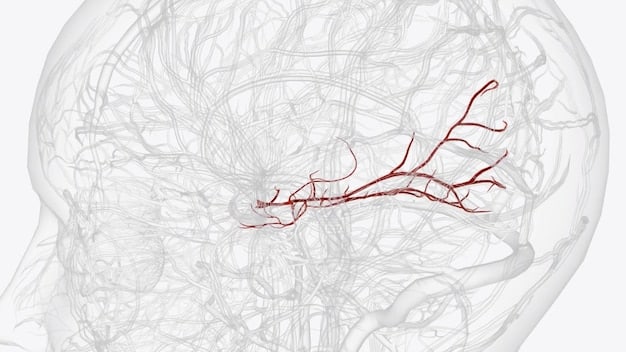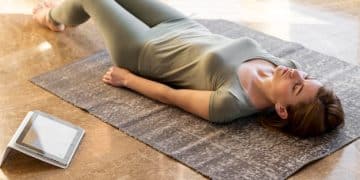Reduce Anxiety: Discover the Benefits of Deep Breathing Exercises

Deep breathing exercises are a powerful and accessible tool to reduce anxiety by promoting relaxation, improving focus, and activating the body’s natural calming mechanisms.
Feeling anxious? You’re not alone. Stress and anxiety are common in today’s fast-paced world. But there’s good news: simple techniques like Reduce Anxiety by 25%: The Benefits of Deep Breathing Exercises can offer significant relief.
Understanding Anxiety and the Body’s Response
Anxiety is a natural human emotion, but when it becomes excessive or persistent, it can significantly impact daily life. Understanding the physiological response to anxiety is crucial to grasping how deep breathing exercises can help.
The Fight-or-Flight Response
When faced with a perceived threat, the body activates the fight-or-flight response. This involves the release of stress hormones like cortisol and adrenaline, leading to increased heart rate, rapid breathing, and heightened alertness. While beneficial in genuinely dangerous situations, chronic stress can keep the body in a state of heightened alert, contributing to anxiety disorders.
The Role of the Autonomic Nervous System
The autonomic nervous system (ANS) controls involuntary bodily functions, including heart rate, digestion, and breathing. It consists of two branches: the sympathetic nervous system (SNS), which activates the fight-or-flight response, and the parasympathetic nervous system (PNS), which promotes relaxation and recovery. Anxiety often involves an overactivation of the SNS and an underactivation of the PNS.

Deep breathing exercises help to counteract this imbalance by stimulating the PNS. When you consciously slow your breathing, you send a signal to the brain that you are safe, prompting the PNS to activate and calm the body down.
Here’s how the ANS is affected by deep breathing:
- Slows heart rate: Deep breathing helps lower an elevated heart rate caused by anxiety.
- Lowers blood pressure: Promoting relaxation assists in reducing blood pressure to healthy levels.
- Reduces muscle tension: Deep breathing encourages muscles to relax, alleviating physical tension.
- Promotes relaxation: Activating the parasympathetic nervous system helps induce an overall feeling of calm.
By understanding the connection between anxiety and the body’s physiological responses, we can appreciate the profound impact of simple techniques like deep breathing exercises.
The Science-Backed Benefits of Deep Breathing
Deep breathing exercises are more than just a feel-good technique; they are backed by scientific research demonstrating their effectiveness in reducing anxiety and improving overall well-being. These benefits extend beyond immediate relief and can contribute to long-term improvements in mental and physical health.
Lowering Cortisol Levels
Studies have shown that deep breathing can significantly lower cortisol levels, the primary stress hormone. Elevated cortisol levels are linked to chronic anxiety, sleep disturbances, and weakened immune function. By reducing cortisol, deep breathing helps to mitigate the negative effects of chronic stress in the body.
Increasing Oxygen Flow to the Brain
Deep, diaphragmatic breathing increases oxygen intake and improves blood flow to the brain. This enhanced oxygenation can boost cognitive function, improve focus, and reduce feelings of fogginess or mental fatigue often associated with anxiety.
Activating the Vagus Nerve
The vagus nerve is the longest nerve in the body and plays a crucial role in regulating mood, digestion, and heart rate. Deep breathing stimulates the vagus nerve, promoting relaxation and reducing anxiety symptoms. Vagal nerve stimulation has also been linked to improved emotional regulation and resilience to stress.

Here are some additional scientific benefits of deep breathing:
- Mood Improvement: Helps to elevate mood and reduce symptoms of depression.
- Improved Sleep: Can lead to better sleep quality by calming the mind and body before bed.
- Pain Reduction: May help to alleviate chronic pain by promoting relaxation and reducing muscle tension.
- Enhanced Focus: Increases concentration and cognitive performance.
These science-backed benefits reveal the profound impact of deep breathing. Incorporating these simple exercises into your daily routine can lead to substantial improvements in both mental and physical well-being.
Breathing Techniques to Reduce Anxiety
There are many different types of deep breathing exercises, each with its own unique focus and technique. The key is to find one (or more) that resonates with you and incorporate it into your daily routine.
Diaphragmatic Breathing (Belly Breathing)
Diaphragmatic breathing, also known as belly breathing, involves engaging the diaphragm, the primary muscle involved in breathing. This technique promotes deeper, more efficient breathing and is highly effective for reducing anxiety. To practice diaphragmatic breathing, lie down or sit comfortably and place one hand on your chest and the other on your abdomen. Inhale slowly through your nose, allowing your abdomen to rise while keeping your chest relatively still. Exhale slowly through your mouth, contracting your abdominal muscles to push the air out. Repeat this process for several minutes, focusing on the rise and fall of your abdomen.
Box Breathing
Box breathing, also known as square breathing, is a simple yet powerful technique that can quickly calm the nervous system. To practice box breathing, inhale slowly through your nose for a count of four. Hold your breath for a count of four. Exhale slowly through your mouth for a count of four. Hold your breath again for a count of four. Repeat this cycle for several minutes, focusing on the equal intervals of inhalation, breath retention, and exhalation.
4-7-8 Breathing
The 4-7-8 breathing technique, popularized by Dr. Andrew Weil, is designed to promote relaxation and improve sleep. To practice 4-7-8 breathing, sit comfortably with your back straight. Place the tip of your tongue against the ridge of tissue just behind your upper front teeth, and keep it there throughout the exercise. Exhale completely through your mouth, making a whooshing sound. Close your mouth and inhale quietly through your nose to a count of four. Hold your breath for a count of seven. Exhale completely through your mouth, making a whooshing sound to a count of eight. Repeat this cycle at least four times.
Consider these popular and beginner-friendly breathing exercises:
- Pursed-lip breathing: Inhale deeply through the nose and exhale slowly through pursed lips, like you’re blowing out candles.
- Alternate nostril breathing: Close one nostril and inhale through the other, then switch nostrils and exhale.
- Lion’s Breath: Inhale deeply and exhale forcefully through your mouth while sticking your tongue out.
Experiment with these techniques to find the methods that work best for you. Regular practice can help to reduce anxiety and promote a sense of calm and well-being.
Integrating Deep Breathing into Your Daily Life
The key to experiencing the benefits of deep breathing exercises is incorporating them into your daily routine. This doesn’t require significant time or effort; even a few minutes of mindful breathing can make a difference.
Set Reminders
In our busy lives, it’s easy to forget to take time for deep breathing. Setting reminders on your phone or calendar can help you stay on track. Schedule short breathing breaks throughout the day, especially during stressful periods.
Combine with Other Activities
Deep breathing can be seamlessly integrated with other activities, such as walking, yoga, or meditation. For example, you can practice diaphragmatic breathing while taking a leisurely stroll in the park or incorporate box breathing into your yoga routine. Combining deep breathing with these activities can enhance their calming effects.
Create a Dedicated Breathing Space
Designate a quiet and comfortable space in your home where you can practice deep breathing without distractions. This space should be free from clutter and noise, and filled with calming elements like plants, soft lighting, or soothing music. Having a dedicated breathing space can help you create a consistent and relaxing practice.
You can also consider these tips:
- Incorporate it into your morning routine: Start your day with a few minutes of deep breathing to center yourself and set a calm tone for the day.
- Use it before bed: Deep breathing can help you relax and prepare for a restful night’s sleep.
- Practice during stressful situations: Use deep breathing as a tool to manage anxiety and stress in the moment.
By incorporating deep breathing into your daily life, you can build resilience to stress and anxiety, and cultivate a greater sense of inner peace.
Mindfulness and Deep Breathing for Enhanced Anxiety Relief
Mindfulness and deep breathing are a powerful combination for managing anxiety. Mindfulness involves paying attention to the present moment without judgment, while deep breathing helps to calm the body and mind. When practiced together, these techniques can amplify each other’s benefits, leading to enhanced anxiety relief.
Mindful Breathing Meditation
Mindful breathing meditation involves focusing your attention on your breath as it enters and leaves your body. As you breathe, notice the sensations of your breath in your nose, chest, and abdomen. When your mind wanders, gently redirect your attention back to your breath. This practice helps to anchor you in the present moment and reduce the tendency to dwell on anxious thoughts.
Body Scan Meditation with Deep Breathing
Body scan meditation involves systematically bringing your attention to different parts of your body, noticing any sensations or areas of tension. While scanning your body, incorporate deep breathing to promote relaxation and release tension. As you inhale, imagine breathing into the area of tension, and as you exhale, imagine releasing the tension. This practice can help you become more aware of your body’s signals and develop a greater sense of embodied presence.
Walking Meditation with Deep Breathing
Walking meditation involves bringing mindful awareness to the act of walking. As you walk, pay attention to the sensations of your feet making contact with the ground, the movement of your body, and the rhythm of your breath. Coordinate your breath with your steps, inhaling for a certain number of steps and exhaling for the same number of steps. This practice can help you connect with your body and surroundings, and reduce feelings of anxiety and restlessness.
Here are some suggestions for practicing mindfulness with deep breathing:
- Use guided meditations: There are many apps and online resources that offer guided meditations incorporating deep breathing and mindfulness techniques.
- Focus on the present moment: When practicing deep breathing, try to let go of thoughts about the past or future and focus solely on your breath.
- Be patient and compassionate: It’s normal for your mind to wander during meditation. Be patient with yourself and gently redirect your attention back to your breath.
By combining mindfulness and deep breathing, you can cultivate a greater sense of presence, reduce anxiety, and enhance your overall well-being.
Potential Challenges and How to Overcome Them
While deep breathing exercises are generally safe and effective, some individuals may encounter challenges when starting out. Understanding potential obstacles and developing strategies to overcome them can help you establish a consistent and rewarding practice.
Hyperventilation
Some individuals may experience hyperventilation, or over-breathing, when first attempting deep breathing exercises. This can lead to feelings of dizziness, lightheadedness, or tingling sensations. To avoid hyperventilation, focus on slow, controlled breathing, and avoid forcing your breath. If you start to feel dizzy, stop the exercise and breathe normally until the symptoms subside.
Difficulty Focusing
It’s common for the mind to wander during deep breathing exercises, especially when you’re new to the practice. If you find it difficult to focus, try using a guided meditation or focusing on a specific aspect of your breath, such as the sensation of air entering and leaving your nose. Be patient with yourself and gently redirect your attention back to your breath whenever your mind wanders.
Emotional Release
Deep breathing can sometimes trigger the release of pent-up emotions. If you experience unexpected feelings of sadness, anger, or fear during or after a deep breathing exercise, acknowledge your emotions and allow yourself to feel them without judgment. If the emotions are overwhelming, seek support from a therapist or counselor.
To ensure success, consider these essential tips:
- Start slowly and gradually increase the duration and intensity of your practice.
- Practice in a quiet and comfortable environment, free from distractions.
- Be patient with yourself and don’t get discouraged if you don’t see results immediately.
Remember that deep breathing is a skill that improves with practice. By addressing potential challenges and remaining persistent, you can reap the numerous benefits of this powerful technique.
| Key Point | Brief Description |
|---|---|
| 😌 Reduces Anxiety | Deep breathing activates the parasympathetic nervous system, promoting relaxation. |
| 🧠 Improves Focus | Increased oxygen flow to the brain enhances cognitive function and concentration. |
| 🧘 Versatile Techniques | Techniques like diaphragmatic, box, and 4-7-8 breathing can be easily integrated into daily life. |
| 🗓️ Daily Practice | Regular practice leads to sustained reductions in anxiety and improvements in well-being. |
Frequently Asked Questions
▼
Many people experience noticeable anxiety reduction within minutes of practicing deep breathing exercises. The calming effect is often immediate, but consistent practice yields longer-term benefits.
▼
While deep breathing is highly effective for managing anxiety symptoms, it may not completely eliminate anxiety disorders. It is often best used in conjunction with therapy or medication, under professional guidance.
▼
There’s no single “best” time, but many find it helpful to practice deep breathing in the morning to start the day calmly, before bed to improve sleep, or during moments of acute stress.
▼
For most people, deep breathing is safe. However, some may experience hyperventilation if not practiced correctly. Focus on slow, controlled breaths and stop if dizziness occurs.
▼
Yes, children can greatly benefit! Simple techniques like belly breathing can help kids manage stress and anxiety. Make it fun by practicing with stuffed animals or in playful settings.
Conclusion
Deep breathing exercises offer a simple, accessible, and powerful way to reduce anxiety and improve overall well-being. By understanding the science behind these techniques and incorporating them into your daily routine, you can cultivate a greater sense of calm, resilience, and inner peace. Take a deep breath and start your journey to a less anxious you today.





